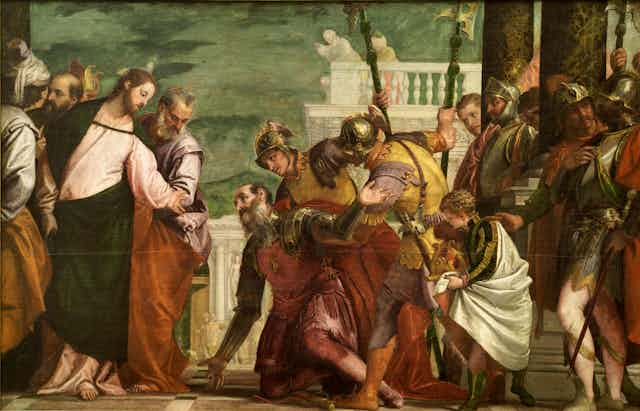A review of the National Gallery’s latest exhibition, Veronese: Magnificence in Renaissance Venice can be short. Why? There’s no umming and ahhing here, it simply must be seen. This is the first ever exhibition of the artist to be held in the United Kingdom.
It presents a selection of his works that does justice to the magnificence mentioned in the title and would normally be impossible to view in the same location, including pieces from the Louvre in Paris, the Gallerie dell’Accademica in Venice, the Kunsthistorisches Museum in Vienna, the Prado in Madrid and various Italian churches.
The National Gallery has staged the show in a flight of seven rooms in the main gallery, which are more spacious than the normal exhibition rooms in the basement of the Sainsbury Wing and, unlike the latter, benefit from natural light. The exhibition is instructive and engaging without being overwhelming. The curator, Xavier F. Salomon of the Metropolitan Museum in New York, has opted for a traditional chronological arrangement, which allows the visitor to follow Veronese’s progression as an artist.
Born Paolo, the son of a stonecutter in Verona in 1528, the artist moved to Venice in 1553. Here he adopted the surname Veronese as a reference to his native city and became one of the most illustrious representatives of Venetian painting, celebrated during his lifetime and long after his death in 1588.
The works displayed in the first two rooms reveal that Veronese was already an accomplished master by the time he decided to try his luck in the city of the great painters Titian and Tintoretto. His particular strengths as an artist are manifest even in the early paintings. Like a film-director from the golden era of Hollywood, he never hesitated to put in a few more extras in a scene if he had a chance.

For example, the Supper at Emmaus from the Louvre has a subject that does not require more than three or four figures; but Veronese has spiced up the composition with a multitude of servants and onlookers in lavish costumes, including two charming little girls playing with a dog who steal the show in the foreground. It is no wonder that the Inquisition was later to chide him for distracting from the religious message of his paintings. He was also adept at portraits, rendering his sitters with a spontaneity that makes it look as if they have been captured in a real moment.
The next rooms demonstrate that once in Venice, Veronese became even better at what he was already exceedingly good at. A striking element in a number of his paintings are the lush fabrics – silks, velvets, brocades – painted with a degree of realism that tempts the viewer to reach out, touch them and experience their different textures. Remarkably, this notable aspect of his work has attracted relatively little attention among scholars.

Veronese, moreover, developed a technique of painting with loose, virtuoso brush-strokes that makes it all look deceptively easy. Long before the invention of 3D cinema, he painted figures that almost jump out of their canvasses – the most spectacular examples on show are perhaps the depictions of St John the Baptist and St Menna.
His talent was not universal; background landscapes are not the best part of his paintings and he seems to have been more at ease working on a large rather than a small scale. But it would be wrong to suggest that Veronese was all about flair and flamboyance. A painting such as The Dream of St Helena from the Vatican Museums combines his typical brilliant ingredients (an array of fine textiles, playful brushwork) with an introvert and intimate mood.
His oeuvre was a source of inspiration for many later artists, including Rubens, Tiepolo and Delacroix. It is surprising that this great master has never before been celebrated with a major exhibition in the UK – but the present show more than makes up for the omission.
Veronese: Magnificence in Renaissance Venice is at the National Gallery in London until 15 June 2014

